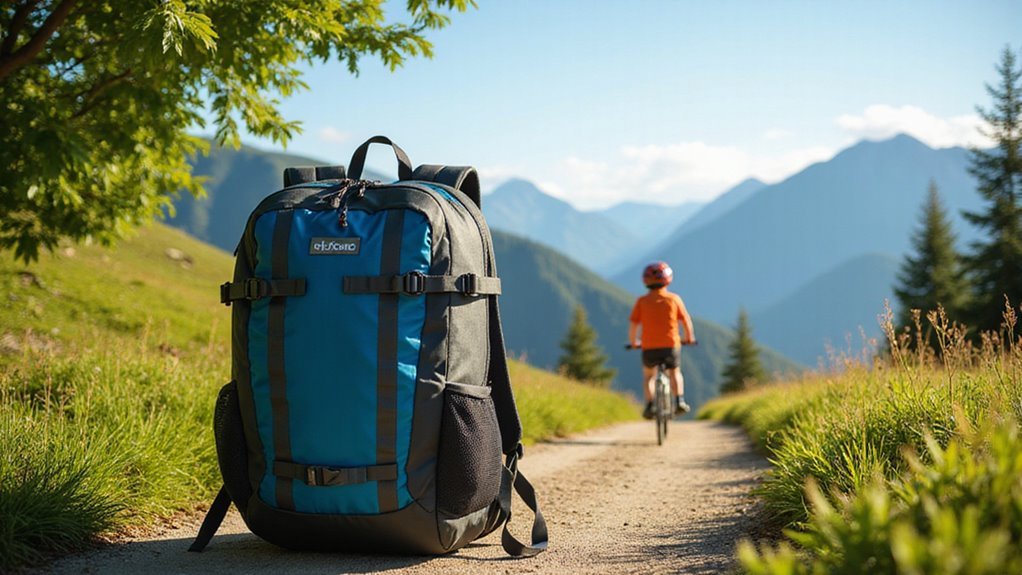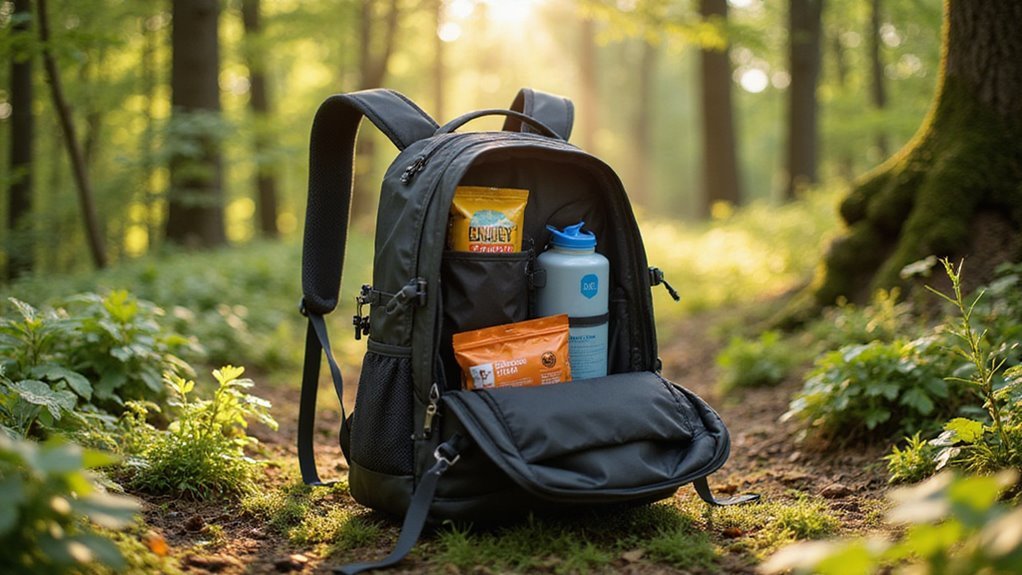Like a well-packed expedition kit, we’re about to unpack the essentials of innovative daypacks that’ll transform your hiking game. We’re seeing a revolution in compact backpack design that’s left the bulky, poorly-organized bags of yesteryear in the dust. Let’s cut through the marketing hype and zero in on what actually matters – because your choice of daypack can make or break your time on the trail.
Essential Features of Modern Daypacks

Daypacks have evolved far beyond simple knapsacks into highly engineered companions for the modern hiker.
Today’s daypacks come equipped with features prioritizing both comfort and convenience, including hydration reservoir sleeves and padded shoulder straps that won’t dig into your shoulders.
We’re seeing smart organization—including dedicated compartments to keep gear accessible and secure.
With water resistance and durability built into their lightweight internal frames, these packs are ready for action.
The adjustable torso lengths guarantee a perfect fit for any body type, while capacities between 21-35 liters hit the sweet spot for day hiking needs. Additionally, many packs incorporate sustainable materials to minimize their environmental impact.
Lightweight Materials and Construction
While traditional hiking packs often felt like carrying a brick wall on your back, modern lightweight materials have revolutionized what’s possible.
We’re seeing compact backpacks engineered with ripstop nylon and frameless designs that redefine durability-to-weight ratios for day hikes.
- Water-resistant coatings and welded seams protect gear without bulk
- Breathable mesh panels maximize airflow while minimizing shoulder strain
- Minimalist features like adjustable straps and roll-top closures cut unnecessary weight
These aren’t your grandfather’s canvas rucksacks.
Today’s durable construction techniques deliver ultralight performance without compromising strength – exactly what we need for quick summit pushes and fast-paced adventures. Additionally, the use of ripstop fabric in these backpacks enhances their tear resistance, ensuring they can withstand rugged conditions.
Storage Solutions and Organization Systems

Modern lightweight materials deserve organized compartments to match their efficiency.
Today’s compact backpacks nail this with storage solutions that maximize every inch. We’re seeing brilliant organization systems in models like the REI Flash 22, which maintains a lightweight structure while delivering essential compartments.
Want efficient organization? Look for hydration sleeves, mesh back panels, and hipbelt pockets – they’re game-changers for quick access. Additionally, organizational compartments play a crucial role in maximizing usability and keeping your gear accessible on the go.
Smart designs like the Osprey Talon 22 and Gregory Citro incorporate adjustable straps and compression systems to keep gear secure. These features aren’t just bells and whistles – they’re your ticket to hassle-free hiking.
Ergonomic Design Elements
Comfort warriors, let’s talk ergonomics – the science that keeps your shoulders happy and your back pain-free. Modern backpacks aren’t just bags; they’re engineered comfort systems featuring contoured shoulder straps and padded hip belts for ideal weight distribution.
- Adjustable torso lengths adapt to your unique build, while ventilated back panels with breathable mesh materials keep you cool.
- Load-lifter straps pull weight closer to your center of gravity, reducing strain.
- Strategically placed pockets and integrated hydration systems guarantee everything’s within reach.
- With advanced ventilation systems, these ergonomic design elements transform your daypack from burden to blessing.
Weather Protection and Durability

Your perfectly engineered backpack needs battle-ready protection against Mother Nature’s mood swings.
We’ll equip you with weather-resistant materials like ripstop nylon, armed with DWR coatings that laugh in the face of rain. Modern packs, including standouts like the Osprey Downburst 36, boast impressive IPX5 water resistance ratings. Additionally, the use of breathable membranes ensures comfort by allowing moisture to escape while keeping the rain out.
Don’t forget the critical defensive line: reinforced stitching and high-quality zippers that won’t surrender to rugged outdoor environments.
For ultimate protection, we’re talking built-in rain covers that deploy at a moment’s notice. It’s lightweight design meets fortress-level durability – because your gear deserves nothing less.
Technical Performance Innovations
While yesterday’s packs relied on brute strength, today’s technical innovations deliver superior performance through intelligent design.
We’re seeing revolutionary advances in lightweight materials and adjustable harness systems that maximize comfort without compromising durability.
- Integrated hydration systems with 2.5L reservoirs eliminate bottle fumbling.
- Mesh back panels with strategic ventilation channels keep you dry and comfortable.
- Specialized pockets and attachment points transform basic bags into technical powerhouses.
These aren’t just incremental improvements – they’re game-changers for day hikers who demand peak performance. Hydration packs offer hands-free hydration, making it easier to stay refreshed on the trail.
Every feature serves a purpose, from the recycled ripstop nylon to the customizable fit systems.
Frequently Asked Questions
How Long Should a Day Hiking Backpack Typically Last With Regular Use?
We’ve seen packs last an eternity! With proper durability factors and material quality, you’ll get 3-5 years, though weather resistance and maintenance tips greatly extend lifespan. Check warranty details and user reviews.
Can I Use a Day Hiking Backpack as Carry-On Luggage?
Yes, we can use hiking backpacks as carry-ons if they meet airline policies and dimensions. They’re often more efficient than regular luggage, but we’ll need to check specific weight limits and travel restrictions.
What’s the Ideal Capacity Range for Short Winter Hikes?
Like sherpas traversing Everest’s challenges, we recommend 25-35L capacity for winter day hikes. You’ll need space for essential layers, insulation, safety gear, waterproof protection, and hydration while keeping pack weight manageable.
Are Compact Hiking Backpacks Suitable for Trail Running Activities?
We’d recommend specialized trail running packs with compact design and adjustable straps. They offer ideal weight distribution, hydration options, and quick access storage while using breathable materials for performance efficiency and comfort.
How Often Should I Clean and Maintain My Day Hiking Backpack?
Let’s not beat around the bush – we recommend cleaning our backpacks monthly, inspecting zippers, removing dirt, checking hydration systems, and deep cleaning seasonally to maintain fabric and eliminate odors.